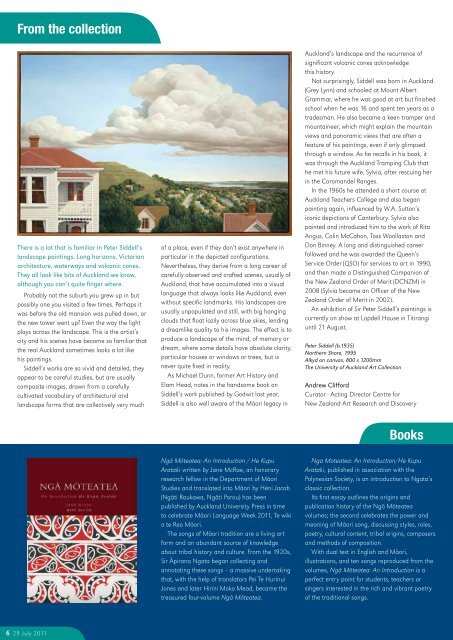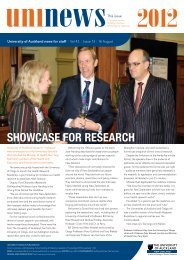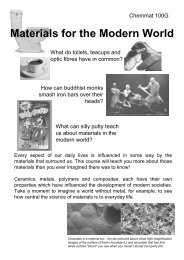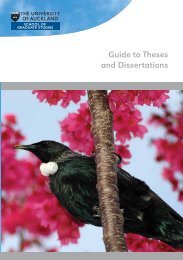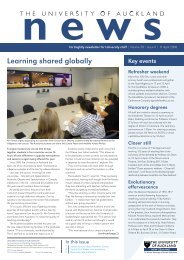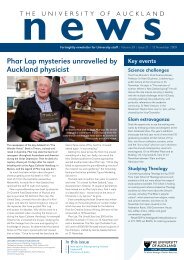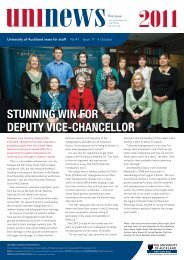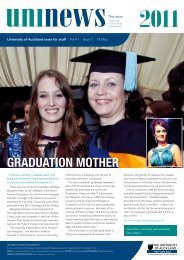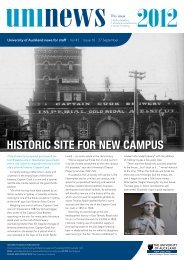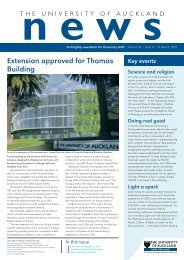Architects' winning design - The University of Auckland
Architects' winning design - The University of Auckland
Architects' winning design - The University of Auckland
Create successful ePaper yourself
Turn your PDF publications into a flip-book with our unique Google optimized e-Paper software.
From the collection<br />
<strong>The</strong>re is a lot that is familiar in peter siddell’s<br />
landscape paintings. long horizons, victorian<br />
architecture, waterways and volcanic cones.<br />
<strong>The</strong>y all look like bits <strong>of</strong> <strong>Auckland</strong> we know,<br />
although you can’t quite finger where.<br />
Probably not the suburb you grew up in but<br />
possibly one you visited a few times. Perhaps it<br />
was before the old mansion was pulled down, or<br />
the new tower went up? Even the way the light<br />
plays across the landscape. This is the artist’s<br />
city and his scenes have become so familiar that<br />
the real <strong>Auckland</strong> sometimes looks a lot like<br />
his paintings.<br />
Siddell’s works are so vivid and detailed, they<br />
appear to be careful studies, but are usually<br />
composite images, drawn from a carefully<br />
cultivated vocabulary <strong>of</strong> architectural and<br />
landscape forms that are collectively very much<br />
6 29 July 2011<br />
<strong>of</strong> a place, even if they don’t exist anywhere in<br />
particular in the depicted configurations.<br />
Nevertheless, they derive from a long career <strong>of</strong><br />
carefully observed and crafted scenes, usually <strong>of</strong><br />
<strong>Auckland</strong>, that have accumulated into a visual<br />
language that always looks like <strong>Auckland</strong>, even<br />
without specific landmarks. His landscapes are<br />
usually unpopulated and still, with big hanging<br />
clouds that float lazily across blue skies, lending<br />
a dreamlike quality to his images. <strong>The</strong> effect is to<br />
produce a landscape <strong>of</strong> the mind, <strong>of</strong> memory or<br />
dream, where some details have absolute clarity,<br />
particular houses or windows or trees, but is<br />
never quite fixed in reality.<br />
As Michael Dunn, former Art History and<br />
Elam Head, notes in the handsome book on<br />
Siddell’s work published by Godwit last year,<br />
Siddell is also well aware <strong>of</strong> the Māori legacy in<br />
Ngā Mōteatea: An Introduction / He Kupu<br />
Arataki written by Jane McRae, an honorary<br />
research fellow in the Department <strong>of</strong> Māori<br />
Studies and translated into Māori by Hēni Jacob<br />
(Ngāti Raukawa, Ngāti Porou) has been<br />
published by <strong>Auckland</strong> <strong>University</strong> Press in time<br />
to celebrate Māori Language Week 2011, Te wiki<br />
o te Reo Māori.<br />
<strong>The</strong> songs <strong>of</strong> Māori tradition are a living art<br />
form and an abundant source <strong>of</strong> knowledge<br />
about tribal history and culture. From the 1920s,<br />
Sir Āpirana Ngata began collecting and<br />
annotating these songs – a massive undertaking<br />
that, with the help <strong>of</strong> translators Pei Te Hurinui<br />
Jones and later Hirini Moko Mead, became the<br />
treasured four-volume Ngā Mōteatea.<br />
<strong>Auckland</strong>’s landscape and the recurrence <strong>of</strong><br />
significant volcanic cones acknowledge<br />
this history.<br />
Not surprisingly, Siddell was born in <strong>Auckland</strong><br />
(Grey Lynn) and schooled at Mount Albert<br />
Grammar, where he was good at art but finished<br />
school when he was 16 and spent ten years as a<br />
tradesman. He also became a keen tramper and<br />
mountaineer, which might explain the mountain<br />
views and panoramic views that are <strong>of</strong>ten a<br />
feature <strong>of</strong> his paintings, even if only glimpsed<br />
through a window. As he recalls in his book, it<br />
was through the <strong>Auckland</strong> Tramping Club that<br />
he met his future wife, Sylvia, after rescuing her<br />
in the Coromandel Ranges.<br />
In the 1960s he attended a short course at<br />
<strong>Auckland</strong> Teachers College and also began<br />
painting again, influenced by W.A. Sutton’s<br />
iconic depictions <strong>of</strong> Canterbury. Sylvia also<br />
painted and introduced him to the work <strong>of</strong> Rita<br />
Angus, Colin McCahon, Toss Woollaston and<br />
Don Binney. A long and distinguished career<br />
followed and he was awarded the Queen’s<br />
Service Order (QSO) for services to art in 1990,<br />
and then made a Distinguished Companion <strong>of</strong><br />
the New Zealand Order <strong>of</strong> Merit (DCNZM) in<br />
2008 (Sylvia became an Officer <strong>of</strong> the New<br />
Zealand Order <strong>of</strong> Merit in 2002).<br />
An exhibition <strong>of</strong> Sir Peter Siddell’s paintings is<br />
currently on show at Lopdell House in Titirangi<br />
until 21 August.<br />
Peter Siddell (b.1935)<br />
Northern Shore, 1995<br />
Alkyd on canvas, 800 x 1200mm<br />
<strong>The</strong> <strong>University</strong> <strong>of</strong> <strong>Auckland</strong> Art Collection<br />
Andrew Clifford<br />
Curator - Acting Director Centre for<br />
New Zealand Art Research and Discovery<br />
Books<br />
Nga Moteatea: An Introduction/He Kupu<br />
Arataki, published in association with the<br />
Polynesian Society, is an introduction to Ngata’s<br />
classic collection.<br />
Its first essay outlines the origins and<br />
publication history <strong>of</strong> the Ngā Mōteatea<br />
volumes; the second celebrates the power and<br />
meaning <strong>of</strong> Māori song, discussing styles, roles,<br />
poetry, cultural content, tribal origins, composers<br />
and methods <strong>of</strong> composition.<br />
With dual text in English and Māori,<br />
illustrations, and ten songs reproduced from the<br />
volumes, Ngā Mōteatea: An Introduction is a<br />
perfect entry point for students, teachers or<br />
singers interested in the rich and vibrant poetry<br />
<strong>of</strong> the traditional songs.


